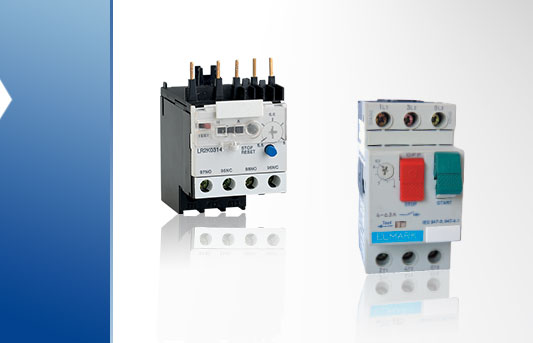
High quality motor protection against overload and overheating.
You could try our E-Business platform without registration where you have an access to the all products, their prices, stock availability, delivery time and technical information.
Description
The choice of a suitable protection prevents motor’s operation at unusual temperature conditions and guarantees maximum constant operation, increases the effectiveness, and prolongs the term of exploitation. That’s why you need to choose only high-quality equipment.
Elmark offers thermal overload relays with nominal voltage up to 690V AC;50/60 Hz.
Browse all Motor and Thermal protection and full technical information here:
These are three pole relays designed for the protection of induction motors from overload or overheat. They are mounted to contactors LT1 K/Dxx series and an operating circuit for motor control is passed through their NC contacts.
Thermomagnetic circuit breakers TM2/TM3 are designed for control and protection of induction motors from overload, overheat, or short circuits. The overload motor protection is carried out by the built-in breaker thermal elements, and the short circuit protection is carried out by the magnetic elements.
These magnetic elements allow the adjustment of the current leakage which is 13 times the maximum current of the thermal protection. The overload protection elements include automatic compensation for the ambient temperature changes.
In combination with under-voltage release the thermomagnetic breaker TM 2-Exx also provides protection of the motors from fall out of a phase from the power supply.
There are additional devices for them available too: voltage release for TM2, waterproof box for TM2 and contact blocks.
Why is motor thermal overload protection important
The work of an electric motor involves high amounts of friction, high frequencies, and at least two magnetic poles. However well designed a motor is, and however, well it has been secure, there is always the chance of it seizing and stopping its movement while current is still passing through it.
In these cases, one of the ways of protecting the sensitive components of an electric motor from burning up by the accumulated heat is by shutting off the power to the motor. Human reaction is too slow, so engineers have come up with a solution in the form of motor thermal protection devices like the LT2 series.
Thermal overload relays have bimetallic releases /1 per phase/ through them the motors current flows and indirectly mated. The bimetallic releases bend subject to the influence of mating and this results in tripping of the relay. The contacts change switch position.
To avoid unwarranted tripping and thermal tripping, there are specific classifications of protection units suitable for small and powerful motors. The more powerful the motor, the more power it will be using and the higher its temperature will be – avoiding the unnecessary stop is done by installing the correct component.
How does it work
In order for such a device to work properly, it have to be mounted to the terminals of the contactor as it is additionally clamped to its frame through a pin and the mounting position also have to be vertical gradient – maximum ± 5°. To protect the consumer from short circuit, before the combination contactor- thermal relay, a suitably measured breaker or safety device should be mounted.
To avoid confusion, it is recommended that these components be installed by professionals – products are rated for industry use and should be handled by trained and certified personnel only.


